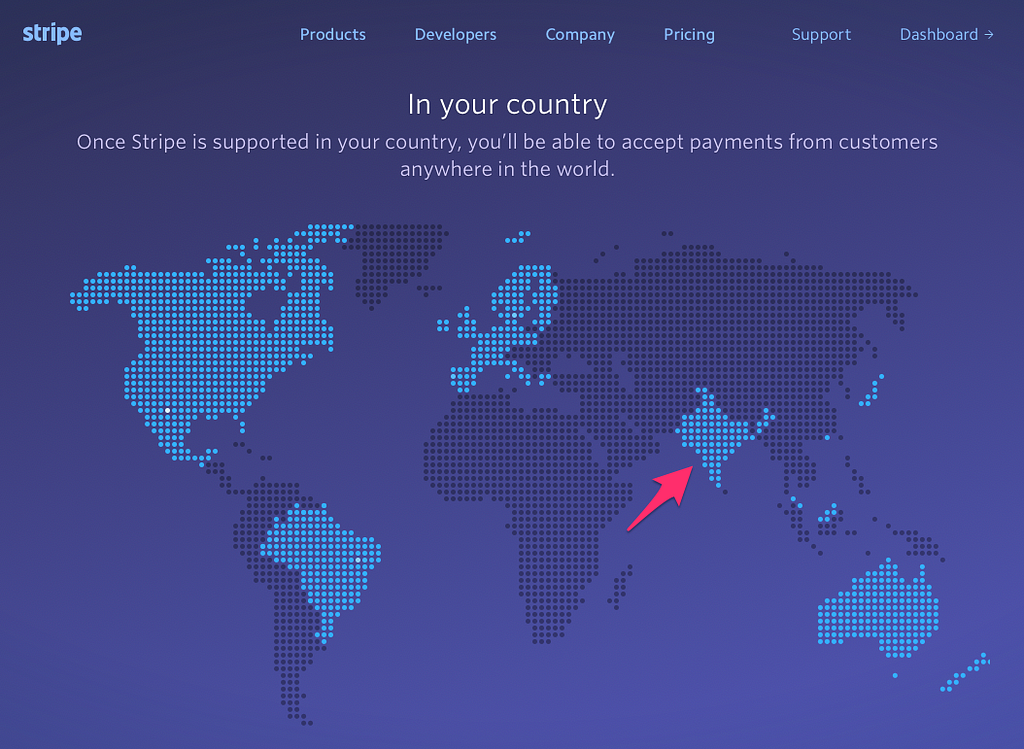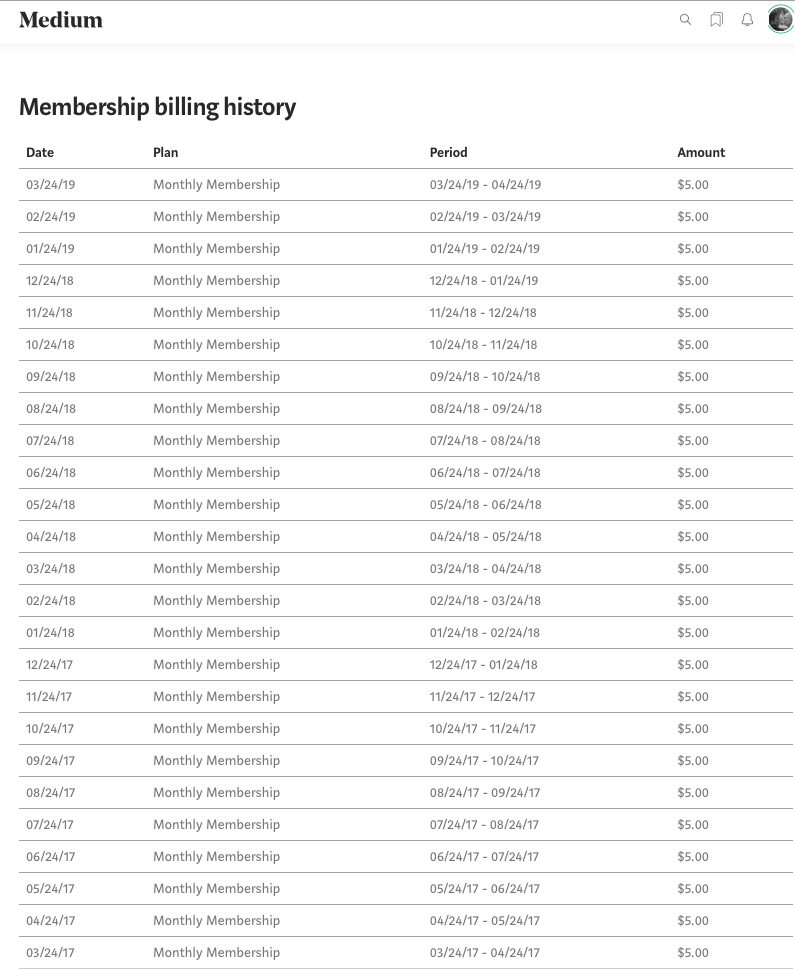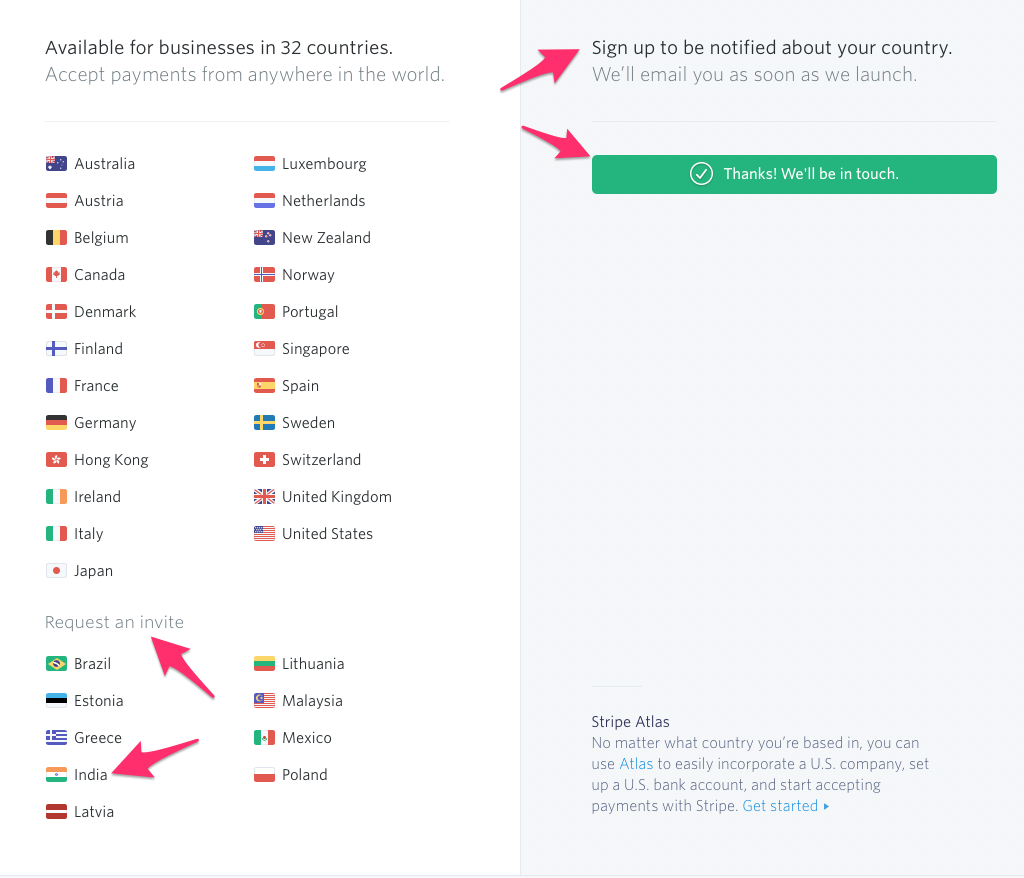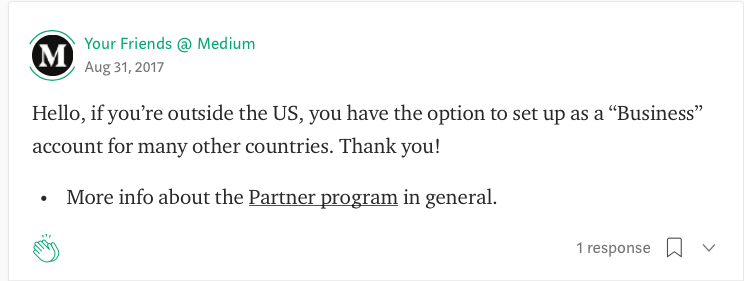Latest news about Bitcoin and all cryptocurrencies. Your daily crypto news habit.
 Fiction: This maps shows countries where Medium pays writers (via Stripe), and includes India.
Fiction: This maps shows countries where Medium pays writers (via Stripe), and includes India.
I’m a Medium member based in India. This morning, I realized the credit card linked to my Medium account is due to expire. So I go to the settings page in my Medium account to check if I can update my card details. I find the button saying ‘Use a new card’ but also notice another button that says ‘View billing history.’ Out of curiosity, I click on it, and am presented with a long list of $5 monthly payments starting from March 24, 2017. Two years, or 25 months to be precise. Which add up to $125 (₹8,645) in membership fees, as of today. That makes me pause, and take stock of what I’m getting for my $125.
 Discriminating by where you live
Discriminating by where you live
Medium has a partnership program that pays writers on the platform. This program only pays writers located in 23 countries, which are mostly wealthier nations. Writers living in the less developed parts of the world don’t get paid because Medium’s payment partner, Stripe, does not offer its services there.
In short, Medium avoids paying writers purely based on where they live. That’s just not right.
A year ago, I wrote a post offering suggestions on how to find a workaround to pay writers outside Medium’s charmed circle.
Is Medium trying to make the rich richer?
Medium claimed to be working at resolving the issue. But a year has gone by since that previous post of mine, and there’s absolutely no progress.
The deafening silence of double standards
Having two standards for writers on Medium who pay the same membership fees is blatantly unfair. What’s particularly damning is Medium’s deafening silence about the issue of these unpaid writers. I went through the Medium’s own blog. There’s not even a mention or discussion about unpaid writers. It’s like we don’t exist. This would imply Medium is aware of the issue, but hoping it will go away if they keep ignoring it.
Assuming Medium is really unable to pay writers from these blacklisted countries, then why not reward them in some other way?
Here’s a suggestion.
Writers from blacklisted countries should have their ‘claps’ evaluated in the same way as their luckier non-blacklisted counterparts in the US. When or if that value equals $5, it should be used to pay their monthly membership fee for the next month. Anything above $5 can be credited to their account, and paid when Stripe sorts out its payment issues. It may not be much, but it’s at least a good gesture on Medium’s part.
Now if I could come up with that thought without even pausing my typing, I’m sure the boffins at Medium should be able to do better. If not, fire them and hire someone with brains, and make sure they have a heart too!
I’ve always believed in the natural goodness of people. I feel if people have a choice, they usually do the right thing. So when Medium said they were trying to sort out the issue, I gave them the benefit of doubt, and continued paying my membership fees for two whole years.
The good, the bad, and the Medium
My relationship with Medium began in 2015. I came upon the site purely by chance, and straightaway fell for its unique blend of clean design and ease of writing and publishing. I liked the platform so much that I posted a whole bunch of articles over the next year, and wasn’t too bothered if anyone read it or not. At that point of time, Medium hadn’t as yet introduced membership fees or put up the paywall. So money didn’t come into the picture. In fact, there wasn’t really anything in it for me except the joy of writing whatever I wished, like this story of a stolen iPod.
Three years later, my stats on Medium say I have written 323 stories. Since Medium labels my responses/comments on stories as individual stories, my guess is the real number of my published stories would be closer to 200.
That’s still a fair bit of writing and shows my involvement with the platform. Like any business, I know Medium needs an income to survive. I also realize that Medium is trying to do something that hasn’t done before, so there are bound to be mistakes. So I have not been worried about their changes of direction. Like when they initially allowed advertising on the platform to generate revenue, but later reversed their decision and moved away from advertising towards a paywall. Most of all, I find it commendable how they have worked out a system to pay writers from the monthly fees of Medium members. The ‘clap’ system isn’t perfect but I’ll give Medium points for trying.
What I don’t appreciate about Medium is the above-mentioned discrimination. Why do they do it? Did things change once Medium started making money from its membership fees? As the song goes, ‘Money changes everything.’
Incompetent Partner
Medium has tied up with a payment platform called Stripe to pay its writers. When you try to join the Medium Partner Program (through which Medium pays writers), you will be directed to Stripe, which claims to be available in 32 countries. Of these, 23 are developed countries. Users in those nations can use Stripe for their financial transactions without any restriction.
India appears in a second list and is even there on the Stripe’s map of countries that it’s active in (see title image). This seems to imply that users can get a Stripe account ‘invite’ on request. That is deceptive as I’ve requested Stripe for an invite several times over the last year. Forget invite, I have yet to even receive an acknowledgment of my many requests from Stripe. If you ask me, Stripes' ‘invite’ is pure eyewash.
India has countless freelancers in diverse fields who take on jobs from companies based outside India, including the US and Europe. They get paid using the many financial platforms that are available. I have covered this subject in detail in my previous post written more than a year ago. Since then, many more options have sprung up to transfer funds to India. This includes Google Pay, which incidentally Stripe uses.
One of my neighbours, an elderly lady, has a daughter who lives in London. Twice a week, the daughter has fresh groceries delivered to her mother in India, while paying for it from London. If an individual can do this, why is it so hard for Medium to make regular payments overseas? More to the point, if Stripe can’t arrange payments to India, they must be extremely incompetent.
This is what makes me skeptical about Medium’s choice of a partner. Is Medium unaware of how incompetent Stripe is? Or is Medium deliberately sticking with Stripe to have an excuse to avoid paying writers in India and elsewhere?
Fool me twice, shame on me
Enough is enough. Doing the math today, made me pause. Two years is a long time to resolve an issue, and $125 isn’t peanuts for someone living in India. There’s a difference between giving Medium the benefit of doubt and being gullible, and I suspect I’m in the second category.
I wrote my previous post on this issue a year ago, at which point I had already paid Medium membership fees for a whole year. Since then, I have paid up a second year of membership fees, and I’m still swallowing Medium’s line of ‘working on it.’
As the old saying goes, ‘Fool me once, shame on you; Fool me twice, shame on me.’
My patience has run out, and it’s time to consider my options.
Option 1: Get a proxy
I do have a simple workaround to get paid. Just ask someone based in US or any of those other 23 countries to collect Medium writer payments on my behalf, by registering their bank account number on my Medium account. In fact, my brother who lives in UK volunteered to do this.
I’m lucky I have a trustworthy resource who is willing to do this for me. But what about the other writers who do not have access to such resources? Not to mention the fact that my brother will have an additional headache while filing his tax returns. So I thanked my brother, and said no.
Medium needs to pay all writers, and I’m not giving them an easy way out.
Option 2: Get a Stripe business account
When I first found that Medium wasn’t paying writers outside the US, I wrote to Your Friends@Medium. They suggested I use a Stripe business account.
Obviously, there’s a catch. It’s horrendously expensive. I checked this out when I wrote my previous post a year ago, and I’m sure the figures will still be similar or probably higher. Here, let me quote from my earlier post.
You basically need to start a US company, which comes at an incorporation cost of US$500, a running cost of $25 per month, a yearly fee of $100 for an agent, plus other sundry costs like $349 for legal advice, and $250 for tax preparation.
This is a ripoff. Let’s move on.
Option 3: Cancel my Medium membership
Option 1 & 2 are not working for me. So canceling my membership seems to be the only way forward for me.
What do I lose by canceling my membership?
How will canceling my Medium membership affect me? Medium has clearly stated that if a writer wants to get paid, he or she has to become a Medium member. That argument is irrelevant, as Medium is anyway not paying me.
How will I be affected as a reader on Medium? To be frank, I have no idea. Like I said, I began writing on Medium before the paywall came up, and was a member after the wall rose. So I don’t know what life beyond Medium’s paywall feels like.
From what I vaguely recall, non-paying members are restricted to three articles a month. I’m sure there are loopholes to get around this restriction, but why take the trouble to do that? Far easier to look elsewhere for good content.
What else? There’s a possibility Medium could kick me out for publishing this post filled with unpatriotic thoughts about the mother platform. It’s a good idea to always be prepared for the unexpected. Hang on for a moment, while I back up all my posts on Medium.
Done.
Advertising blues
At one point, advertising was the preferred source of income for any enterprise on the net. But the world turned against ads once they started popping up all over the place, driving readers crazy, influencing editorial, and incentivizing companies like Facebook to steal our private data, and change the course of history. That led to the rise of ad blockers and the like.
Medium seems to be riding this anti-advertising wave when it decided to remove all advertising from its platform. Personally, I think it’s a good thing, though it does cut off a valuable source of revenue for Medium.
My point is Medium’s paywall was inevitable.
Paywalls are the future
Facebook is still making billions from ads, which means advertising is adapting to survive in a changing world. But Facebook’s change of focus towards merging and encrypting its three messaging platforms (WhatsApp, Instagram and Facebook Messenger) seems to indicate Facebook knows change is inevitable.
Google has shown how our data can be used responsibly. I have been using Google products for many years, and they have enriched my life in many ways, without misusing my data, fingers crossed. The search engine Duck Duck Go has also shown how advertising based on ‘search keywords,’ is a viable business, though not as wildly profitable as data sharing.
However the fact is people are becoming reluctant to trust ads, and more open to the idea of paywalls. Publications like NYT have been successfully doing it for a while now, and many more have joined or will be joining soon.
So yes, paywalls are trending, and sooner or later, I’m going to have to subscribe to a paywalled publication if I want good reading content.
Medium is like a second car
As a reading cum paid-writing platform, Medium gets my vote and my money. But if I’m an unpaid writer, then ‘writing’ goes out of the equation, and Medium is in a different ballgame. Medium will have to compete for my $5 with other publications, purely based on the quality of its ‘reading content.’
I agree Medium has great original content, but it can’t be my first choice. To use a metaphor, Medium is more like a second car than your everyday workhorse, and I speak as a writer on Medium, who loves the platform. (Point to note: lots of people manage with just one car.)
Take the just launched Apple News app. From what I hear, it’s managed to include some of the world’s top publications and will cost $10/month in the US. It may take a while to reach India. My guess is it may launch for as little as $2/month* in India. Why would any reader pay $5 for Medium’s content when they can get Apple’s far richer content at around the same price?
*Here’s how I arrived at that $2/month pricing estimate for Apple News. India is an extremely price-sensitive and complex market. A look at the music industry is quite revealing. Apple Music in India costs costs just $1.75/month (₹120) as against $10/month in the US. Even at this price, Apple Music is barely competitive. Spotify’s Premium version costs ₹129/month, while the basic Spotify is free. JioSaavn has a free version for users of the Jio cellular network, while JioSaavn Pro version costs ₹99/month, which is the same as Gaana and Wynk. Then there’s Amazon Music. I subscribed to this at ₹1000 or $15/year (₹129 or $2 /month) because it’s part of the Amazon Prime package deal, which also includes the usual free delivery for Amazon Prime shopping, movie/ video streaming on Amazon Prime Video, books on Kindle, and more. I must add that Apple has learned this lesson the hard way, with its exorbitantly priced iPhone having a minuscule 1% of India’s cellphone market. As for ‘news’ itself, it’s highly subsidized in India. My 16-page hard copy of India’s leading English daily newspaper, ‘The Times of India,’ costs me ₹120 ($1.75)/month.
Time to take a stand
To sum up, I don’t lose much by canceling my Medium membership. I can still write and publish (and not get paid) as usual on Medium. Reading will be a pain with the three articles a month restriction. I’ve heard there are loopholes to get around that, like visiting via Medium’s Twitter page. Even so, the constant nags to sign up for a Medium membership will be a major irritant. I’m seriously tempted to just pay up by the $5 and stay inside the paywall.
No pain, no gain.
Medium needs fee-paying writers like me, more than we need Medium. So if more fee-paying writers stop paying (hint, hint!), Medium is more likely to get their act together and do the right thing. As they say, money talks.
I’m not holding my breath. On April 24, 2019, my next payment to Medium will be due, and it will bounce as I don’t plan to update the expired credit card linked to my Medium account. And Club Medium is going to lose a member.
After all, if I don’t stand up for myself, who will?
Why I quit my Medium membership was originally published in Hacker Noon on Medium, where people are continuing the conversation by highlighting and responding to this story.
Disclaimer
The views and opinions expressed in this article are solely those of the authors and do not reflect the views of Bitcoin Insider. Every investment and trading move involves risk - this is especially true for cryptocurrencies given their volatility. We strongly advise our readers to conduct their own research when making a decision.

